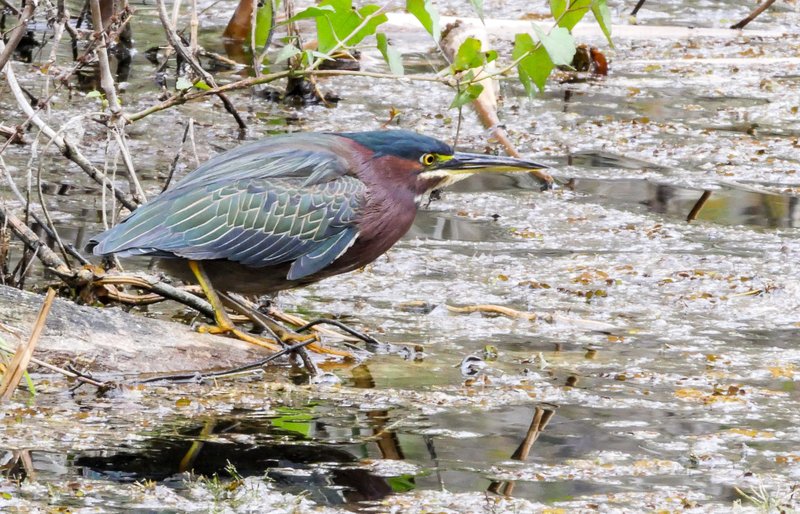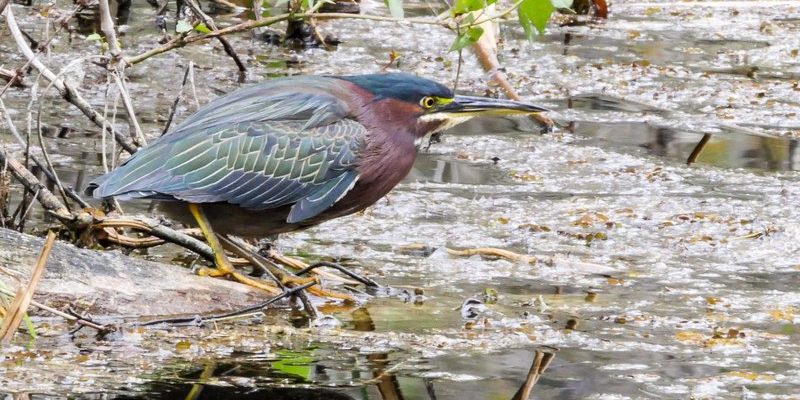
But where exactly do these birds thrive? Herons are not just limited to one region; they’ve adapted to various environments across the globe. From North America’s vast wetlands to the lush tropical regions of Africa and Asia, herons have a remarkable range. Let’s dive into the different habitats and geographical ranges where you can look for these fascinating birds.
North America: Wetlands and Marshes
In North America, herons are often seen in wetlands, marshes, and along the edges of lakes and rivers. The Great Blue Heron, one of the most notable species, can be spotted across most of the continental U.S. and Canada. These birds prefer calm waters where they can wade and hunt for fish, frogs, and other small creatures.
You might think of places like the Florida Everglades or the coastal marshes of Louisiana as excellent heron hotspots. Wetlands here are rich in biodiversity, providing not only food but also nesting opportunities. During migration seasons, many herons flock to these areas, making it a perfect time for birdwatchers to grab their binoculars and head out.
Here are a few notable spots where you can see herons in North America:
- Everglades National Park, Florida
- Chesapeake Bay, Maryland and Virginia
- Okefenokee Swamp, Georgia
- Great Basin, Nevada
Europe: Rivers and Coastal Areas
Across Europe, herons like the Grey Heron inhabit a variety of environments, including rivers, lakes, and even coastal areas. These birds have adapted well to urban settings too, often seen in parks and gardens near water sources. They thrive in places with easy access to fish and small aquatic animals, making riverbanks and marshes prime spots for sightings.
In the UK, for example, you might find herons around the River Thames or in the wetlands of Norfolk. These areas not only offer an abundance of food but also provide safe nesting sites away from predators. In fact, herons are known to build their nests high up in trees or reed beds, keeping their young safe as they learn to fish.
Some key locations to spot herons in Europe include:
- Camargue, France
- Lake Geneva, Switzerland
- Norfolk Broads, England
- Wadden Sea, Netherlands
Africa: Tropical Wetlands and Rivers
Moving to Africa, herons such as the African Sacred Ibis and the Goliath Heron can be found in tropical wetlands, rivers, and lakes. These birds are often seen hunting near the shores of the Nile or in the wetlands of Botswana’s Okavango Delta, a UNESCO World Heritage site known for its rich wildlife.
Herons in Africa tend to have a more varied diet, often feasting on fish, insects, and even small mammals. The wetlands here provide an ideal habitat, rich with nutrients and teeming with life. Watching these majestic birds in action can be a breathtaking experience, especially during sunrise when the waters are calm, reflecting the vibrant colors of the sky.
Here are some prime locations to catch a glimpse of herons in Africa:
- Okavango Delta, Botswana
- Lake Victoria, Uganda
- Lake Nakuru, Kenya
- Nile River, Egypt
Asia: Diverse Habitats from Coasts to Wetlands
Asia is home to a variety of heron species, including the Eastern Cattle Egret and the Indian Pond Heron. These birds can be spotted in rice paddies, coastal areas, and riverbanks. Countries like India and Thailand boast rich biodiversity and are ideal for heron watching. The wetlands in these regions offer not only abundant food sources but also critical habitats for nesting.
When wandering through these areas, you might notice herons working alongside farmers in the fields, helping to control pests while they hunt. This symbiotic relationship highlights how herons have adapted to thrive alongside human activities.
In Asia, some excellent places to spot herons include:
- Keoladeo National Park, India
- Sundarbans, Bangladesh and India
- Chao Phraya River, Thailand
- Yangtze River Delta, China
Australia: Coastal and Inland Wetlands
Herons in Australia, such as the White-faced Heron and the Great Egret, can be found in both coastal areas and inland wetlands. Australia’s diverse environments, from the Great Barrier Reef to the sprawling Outback, provide numerous opportunities for birdwatching. Herons are often seen along mangrove shores and in estuaries, where they hunt for fish and crustaceans.
You might be surprised to learn that herons are also common in urban areas, like Sydney’s parks and botanical gardens, where water features attract them. This adaptability shows how these birds can thrive in various environments, making them a delightful sight for locals and tourists alike.
Some top locations to observe herons in Australia include:
- Watarrka National Park, Northern Territory
- Bowra Station, Queensland
- Port Philip Bay, Victoria
- Lake Monger, Western Australia
Conservation: Protecting Heron Habitats
While it’s wonderful to spot herons in their natural habitats, it’s essential to consider their conservation. Many heron species face threats from habitat destruction, pollution, and climate change. Wetlands are particularly vulnerable, often being drained for agriculture or urban development.
You might wonder why this matters. Well, herons play a vital role in their ecosystems, helping to maintain balance by controlling fish populations and serving as indicators of environmental health. Protecting their habitats ensures that these majestic birds—and the ecosystems they inhabit—can thrive.
Conservation efforts are underway in many regions to preserve wetland areas and educate communities about the importance of these ecosystems. Supporting local conservation initiatives can make a significant difference.
Planning Your Heron Spotting Adventure
If you’re itching to see herons in action, planning your adventure is key. Start by researching local wetlands or nature reserves known for birdwatching. Consider joining a guided tour or local birdwatching group; experienced guides can help you spot these elusive birds and share insights about their behavior and habitats.
Timing is also essential. Early mornings or late afternoons are often the best times to see herons, as they are most active during these hours. Bring binoculars, a field guide, and some patience—heron watching is all about enjoying the moment and appreciating nature.
Don’t forget your camera! Capturing a heron striking a pose in the water can make for a memorable keepsake of your adventure.
In conclusion, herons are not only stunning birds but also vital components of their ecosystems. Whether you spot one in a quiet North American marsh or a tropical African wetland, each encounter is a reminder of the beauty and complexity of nature. So grab your gear, explore the diverse habitats around you, and enjoy the thrill of spotting these charming birds in the wild!

